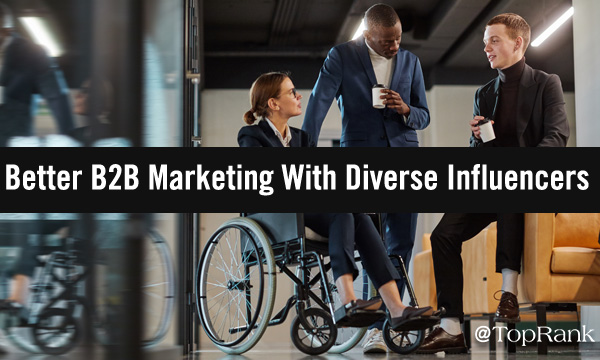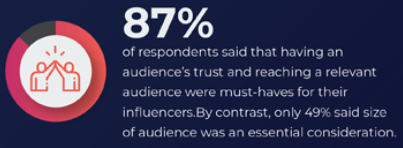
 When was the last time you saw someone in a wheelchair in your day-to-day life? Someone just going about their daily routine, who also happened to be in a wheelchair? Now, when was the last time you saw someone in a wheelchair as a main character in a movie — a movie that wasn’t entirely about being in a wheelchair? You can apply that same thought experiment to any type of diversity: race, gender, sexuality, body size and shape are all underrepresented in the media. If a cisgender, heterosexual white man like me can see this lack of representation, how does it look and feel to those who are in marginalized groups? What is the entertainment industry missing out on by ignoring these voices? Granted, B2B marketers are not in the entertainment business. We’re here to reach an audience and compel them to take an action that benefits the brand. Which means we have even more reason to make sure our work reflects the diversity in the world around us. [bctt tweet="“We’re here to reach an audience and compel them to take an action that benefits the brand. Which means we have even more reason to make sure our work reflects the diversity in the world around us.” — Joshua Nite @NiteWrites" username="toprank"] Here’s why B2B marketers should be considering diversity, equity and inclusion when working with influencers.
When was the last time you saw someone in a wheelchair in your day-to-day life? Someone just going about their daily routine, who also happened to be in a wheelchair? Now, when was the last time you saw someone in a wheelchair as a main character in a movie — a movie that wasn’t entirely about being in a wheelchair? You can apply that same thought experiment to any type of diversity: race, gender, sexuality, body size and shape are all underrepresented in the media. If a cisgender, heterosexual white man like me can see this lack of representation, how does it look and feel to those who are in marginalized groups? What is the entertainment industry missing out on by ignoring these voices? Granted, B2B marketers are not in the entertainment business. We’re here to reach an audience and compel them to take an action that benefits the brand. Which means we have even more reason to make sure our work reflects the diversity in the world around us. [bctt tweet="“We’re here to reach an audience and compel them to take an action that benefits the brand. Which means we have even more reason to make sure our work reflects the diversity in the world around us.” — Joshua Nite @NiteWrites" username="toprank"] Here’s why B2B marketers should be considering diversity, equity and inclusion when working with influencers.
1 — It’s table stakes
For decades, white heterosexual folks were the default for advertising and marketing. When an ad went outside of the mainstream, it was notable, even shocking to some. I remember the first TV ad that showed two men picking out furniture together and the firestorm that ensued. Now, however, it’s the opposite. People are far more in tune with the lack of diversity in marketing and they expect brands to do better. If your influencer campaign features 10 thought leaders in an industry, and they all happen to be middle-aged white men, that’s going to raise eyebrows. It can make your brand appear careless at best and out-of-touch at worst. “But Josh,” an imaginary person argues with me, “We’re just picking the people with the biggest audience!” Well, fictional antagonist, you should know that relevance and authenticity are far more important than audience size in B2B influencer marketing. In our recent survey, less than half of respondents said audience size was an essential consideration, while 87% said authority and relevance were must-haves. In short: Your audience expects to see diverse voices in your content, and will notice an absence thereof.
In short: Your audience expects to see diverse voices in your content, and will notice an absence thereof.
2 — Greater relevance to your audience
What are the odds that every decision maker you’re targeting is of the same race, gender, ethnicity, etc? Vanishingly small. But what are the odds every single decision influencer, every member of the buying committee, and their friends and family are all in a single demographic? You see where I’m going with this. If the people we want to reach are diverse, we need diverse voices to reach them. We need people who can speak with authority to their peers in historically marginalized groups. An influencer in one of these groups can capture the nuances of culture and language that might elude even the most empathetic marketer [bctt tweet="“If the people we want to reach are diverse, we need diverse voices to reach them.” — Joshua Nite @NiteWrites" username="toprank"]3 — Increased integrity/authenticity
Odds are your brand has a diversity initiative underway right now. Most brands are touting their commitment to diversity, equity and inclusion on press releases, social media, billboards, carrier pigeons — you get the idea. But talking about that commitment isn’t anywhere near as powerful as demonstrating it. A recent Live with Marketers roundtable from our client LinkedIn features examples of brands actively promoting diverse voices and helping solve problems experienced by marginalized communities. When done properly, brands can achieve social impact, increase revenue, and improve reputation at the same time. If your brand is committed to diversity (on paper), but every eBook features exclusively white male influencers, people will notice, and they’ll know you don’t practice what you preach. On the flipside, an eBook with thought leaders of all races and genders is a more powerful expression of commitment to diversity than even the most sincere LinkedIn post.4 — Richer content
The thing about people with similar life experiences and cultural backgrounds, is they tend to have similar things to say. That’s not to say everyone is exactly the same, of course — just to say that we as marketers should be seeking out a variety of lived experience for our content. If you’re in the demographic majority (like me), odds are you don’t know — can’t know — what you’re missing from your content. Until, that is, you hear it from people with differing life experiences to your own. There’s simply no substitute for diverse voices to enrich your content.5 — Expanded worldview and enhanced empathy
The first four headers were all about how diversity makes your content better for your audience. This last one is more about us as marketers and as fellow human beings. One of my favorite things about this job is getting to pick the brains of experts on a ton of different topics. Thanks to our influencers, I can explain what SD-WAN, uncoupled Drupal, and Building Information Modeling are. I’ve heard about climate change initiatives in Belgium and sustainable fishing in Alaska, and beyond. All of the diverse folks I have been privileged to interview have helped expand my personal window on the world. They have made me a better, more informed person, which incidentally also makes me a better marketer. The more we learn about all the different people we’re trying to reach, the better we’ll be able to reach them with something of genuine relevance and value.Diversity is a rewarding responsibility
If you’re looking for influencers for your B2B content, it’s your responsibility to keep diversity in mind. Fortunately, as I’ve been saying, a diverse slate of influencers benefits the brand, your audience, the influencers themselves, and even you as a professional and a person. In short: Diversity isn’t a box to check, and it certainly isn’t an extra burden. It’s just the best of best practices. Get a head start on hearing diverse viewpoints with this article: 10 Influencer Marketing Predictions from Experts and Influencers.The post How B2B Marketers Can Benefit From Working With More Diverse Influencers appeared first on B2B Marketing Blog - TopRank®.
0 Commentaires